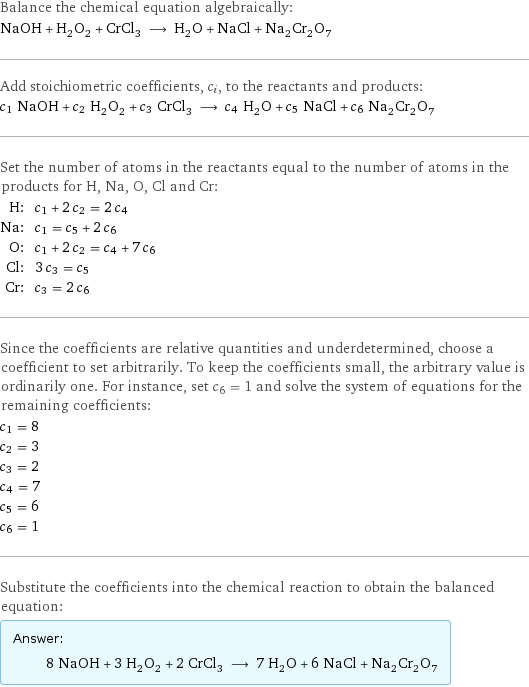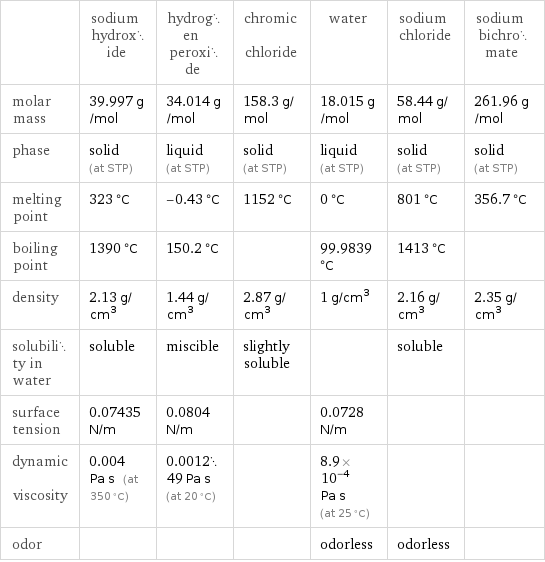Input interpretation

NaOH sodium hydroxide + H_2O_2 hydrogen peroxide + CrCl_3 chromic chloride ⟶ H_2O water + NaCl sodium chloride + Na_2Cr_2O_7 sodium bichromate
Balanced equation

Balance the chemical equation algebraically: NaOH + H_2O_2 + CrCl_3 ⟶ H_2O + NaCl + Na_2Cr_2O_7 Add stoichiometric coefficients, c_i, to the reactants and products: c_1 NaOH + c_2 H_2O_2 + c_3 CrCl_3 ⟶ c_4 H_2O + c_5 NaCl + c_6 Na_2Cr_2O_7 Set the number of atoms in the reactants equal to the number of atoms in the products for H, Na, O, Cl and Cr: H: | c_1 + 2 c_2 = 2 c_4 Na: | c_1 = c_5 + 2 c_6 O: | c_1 + 2 c_2 = c_4 + 7 c_6 Cl: | 3 c_3 = c_5 Cr: | c_3 = 2 c_6 Since the coefficients are relative quantities and underdetermined, choose a coefficient to set arbitrarily. To keep the coefficients small, the arbitrary value is ordinarily one. For instance, set c_6 = 1 and solve the system of equations for the remaining coefficients: c_1 = 8 c_2 = 3 c_3 = 2 c_4 = 7 c_5 = 6 c_6 = 1 Substitute the coefficients into the chemical reaction to obtain the balanced equation: Answer: | | 8 NaOH + 3 H_2O_2 + 2 CrCl_3 ⟶ 7 H_2O + 6 NaCl + Na_2Cr_2O_7
Structures

+ + ⟶ + +
Names

sodium hydroxide + hydrogen peroxide + chromic chloride ⟶ water + sodium chloride + sodium bichromate
Equilibrium constant
![K_c = ([H2O]^7 [NaCl]^6 [Na2Cr2O7])/([NaOH]^8 [H2O2]^3 [CrCl3]^2)](../image_source/2b1d0a4b7cfdb92c3c4c1ce023957097.png)
K_c = ([H2O]^7 [NaCl]^6 [Na2Cr2O7])/([NaOH]^8 [H2O2]^3 [CrCl3]^2)
Rate of reaction
![rate = -1/8 (Δ[NaOH])/(Δt) = -1/3 (Δ[H2O2])/(Δt) = -1/2 (Δ[CrCl3])/(Δt) = 1/7 (Δ[H2O])/(Δt) = 1/6 (Δ[NaCl])/(Δt) = (Δ[Na2Cr2O7])/(Δt) (assuming constant volume and no accumulation of intermediates or side products)](../image_source/d794d5a90c715be1d892e80c1a4a29ab.png)
rate = -1/8 (Δ[NaOH])/(Δt) = -1/3 (Δ[H2O2])/(Δt) = -1/2 (Δ[CrCl3])/(Δt) = 1/7 (Δ[H2O])/(Δt) = 1/6 (Δ[NaCl])/(Δt) = (Δ[Na2Cr2O7])/(Δt) (assuming constant volume and no accumulation of intermediates or side products)
Chemical names and formulas

| sodium hydroxide | hydrogen peroxide | chromic chloride | water | sodium chloride | sodium bichromate formula | NaOH | H_2O_2 | CrCl_3 | H_2O | NaCl | Na_2Cr_2O_7 Hill formula | HNaO | H_2O_2 | Cl_3Cr | H_2O | ClNa | Cr_2Na_2O_7 name | sodium hydroxide | hydrogen peroxide | chromic chloride | water | sodium chloride | sodium bichromate IUPAC name | sodium hydroxide | hydrogen peroxide | trichlorochromium | water | sodium chloride | disodium oxido-(oxido-dioxo-chromio)oxy-dioxo-chromium
Substance properties

| sodium hydroxide | hydrogen peroxide | chromic chloride | water | sodium chloride | sodium bichromate molar mass | 39.997 g/mol | 34.014 g/mol | 158.3 g/mol | 18.015 g/mol | 58.44 g/mol | 261.96 g/mol phase | solid (at STP) | liquid (at STP) | solid (at STP) | liquid (at STP) | solid (at STP) | solid (at STP) melting point | 323 °C | -0.43 °C | 1152 °C | 0 °C | 801 °C | 356.7 °C boiling point | 1390 °C | 150.2 °C | | 99.9839 °C | 1413 °C | density | 2.13 g/cm^3 | 1.44 g/cm^3 | 2.87 g/cm^3 | 1 g/cm^3 | 2.16 g/cm^3 | 2.35 g/cm^3 solubility in water | soluble | miscible | slightly soluble | | soluble | surface tension | 0.07435 N/m | 0.0804 N/m | | 0.0728 N/m | | dynamic viscosity | 0.004 Pa s (at 350 °C) | 0.001249 Pa s (at 20 °C) | | 8.9×10^-4 Pa s (at 25 °C) | | odor | | | | odorless | odorless |
Units
